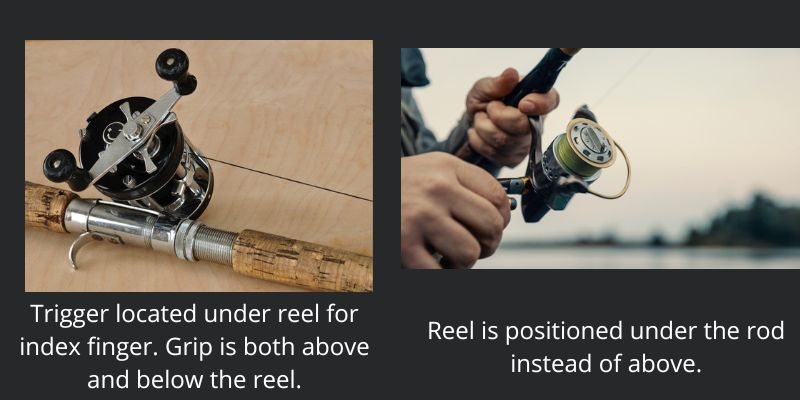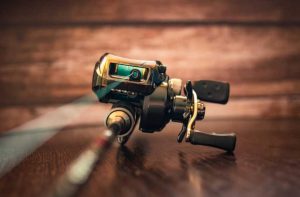Some anglers prefer spinning reel systems, while others prefer baitcasters. In this article, we compare the two systems (baitcasting vs spinning reels) and help you decide which is best for you.
What Is A Baitcasting Reel?
Baitcasting reels are also known as baitcasters or casting reels. They’re reel-and-rod combos where the reel is mounted on top of the rod and the spool unravels in the same direction as the rod itself. Baitcasting reels are great for accurately placing bait in a specific spot and for making long casts, but are much more susceptible to tangles and bird’s nests.
Read our article on how to choose the best baitcasting reel to learn more.
What Is A Spinning Reel?
A spinning reel, also known as an open-faced reel, is a type of fishing reel where the line unwinds from a fixed spool. It’s mounted underneath the rod and the handle is on the side of the reel. Their is a bail that opens or closes allowing the spool to spin freely, or be reeled in smoothly. The spinning reel is one of the most common types of fishing reels among anglers because it’s very versatile, very easy to use, and can be used for a variety of different fishing situations.
Now that we’ve gone over the basics of baitcasting reels and spinning reels, it’s time to compare the two and help you decide which one is right for your needs.
Baitcasting Vs Spinning Reels: What’s The Difference?
- Baitcasting reel is best for more experienced anglers because it takes more practice to use and can be susceptible to tangles.
- A spinning reel is much easier to use and is a great choice for beginners or those looking for a versatile reel system.
- Baitcasting reels are mounted on top of the rod while spinning reels are mounted underneath the rod.
- Baitcasting reel spools spin in the same direction as the rod while spinning reel spools spin in the opposite direction of the rod
- Spin reels are very easy to solve tangle issues, and tend to tangle less severely than baitcasting reels

When To Use A Baitcasting Reel Over A Spinning Reel
Baitcasting reels are great for making long casts and placing lures in a specific spot. It is worth noting that many spin anglers will say they have the same accuracy as baitcasters. Baitcasting reels may be difficult to master, but the free spinning spool allows for tons of power, accuracy, quick casting, and particularly good underhanded casting. Because of the ease of tangle and the relative difficulty for a beginner to simply pick up and learn how to use a baitcasting reel successfully, they are generally recommended for more experienced anglers.
Spinning reels are extremely versatile, allow for easy casting, and therefore are recommended for beginner to advanced fisherman. If an angler doesn’t need to have absolute maximum distance or accuracy, then they likely can get away with the average spinning reel.
If you don’t mind spending the time to learn how to use a baitcaster, then it can be a great addition to your fishing arsenal. If you’re looking for an easy to use reel that can be used in a variety of fishing situations, then a spinning reel is the way to go. No matter which route you choose, baitcasting or spinning, make sure you do your research and purchase a quality reel that will last you for years to come.
In addition, baitcasting reels take less effort as anglers don’t need to use the other hand to open or close the bail. It makes underhand casts easy, and some may prefer baitcasters if they are fishing for a long day.
Often, baitcasting reels are placed on rods that are shorter and more stiff than spin reels, meaning they can handle larger fish a little easier1, and casting in tight scenarios may be easier.
Pros Of A Baitcasting Reel
- Tends to be more accurate
- Tends to be better suited for under hand casts
- Tends to cast larger lures more effectively
- Can place bait in a specific spot
- Casting can be done with one hand without the other hand needing to release a bail, therefore, it takes less effort.
Cons Of A Baitcasting Reel:
- Takes more practice to use
- Susceptible to tangles and bird’s nests, particularly from backlash
- It can be difficult to cast into the wind or cast with small lures
Pros Of A Spinning Reel:
- Easy to use
- Very versatile
- Great for beginners
- Tends to be better with lighter lures
Cons Of A Spinning Reel:
- Not as accurate as baitcasting reel
- Spinning reels are more susceptible to line twist due to the nature of the reel.
Baitcasting Rods Vs Spin Rods
In addition to having differences between the reels, the rods often have some slight differences as well.
Many baitcasting rods have a “trigger” integrated into the handle, allowing an angler to grab on to something when palming the reel. Spinning rods do not have this feature as the spool is located under the rod where your index finger would be normally. Many modern day baitcasting rods no longer have a trigger, and feature a handle above and below the reel for easier two handed casting.
The guides along the rod for baitcasting rods tend to be smaller than the guides on spin rods. This is due to the fact that spin rods have the line rotating out of the spool in such a way that the bottom guide, or bottom two guides need to be larger in order to reduce friction on the line coming out of the spool.

Casting A Baitcasting Reel Vs Casting A Spin Reel
The easiest way is to show you the difference in a video which this one does a great job:
What Is Backlash?
Backlash on a baitcaster is a common problem for anglers. Any variation in the speed of the lure has a negative impact since the spool spins as a consequence of the weight of the lure and the angler’s movement to draw it out. That means that if your lure slows down or hits an object, your spool continues to spin, and creates backlash (aka a birds nest).
This means that anglers need to use their thumb effectively to control the speed of the spool to avoid this backlash. This can be difficult with light lures, high winds, or in areas where you may accidently hit trees, branches, or other objects accidently.
Backlash can sometimes be easy to untangle, and other times, it may mean you need to cut the line and respool.
Which One Should You Choose?
It really depends on your level of experience and what you are looking for in a reel. If you don’t mind spending the time to learn how to use a baitcaster, then it can be a great addition to your fishing arsenal. If you’re looking for an easy to use reel that can be used in a variety of fishing situations, then a spinning reel is likely the way to go.
Generally speaking, if you need to be asking yourself which you should go with, a spinning reel is probably the better choice. For the most part, only advanced anglers are going to get added value out of utilizing a baitcasting reel.
Other Types Of Fishing Rods
Read our guide on the types of fishing rods if you are curious about all the different available rods and reels to choose from.
Max DesMarais is the founder of hikingandfishing.com. He has a passion for the outdoors and making outdoor education and adventure more accessible. Max is a published author for various outdoor adventure, travel, and marketing websites. He is an experienced hiker, backpacker, fly fisherman, backcountry skier, trail runner, and spends his free time in the outdoors. These adventures allow him to test gear, learn new skills, and experience new places so that he can educate others. Max grew up hiking all around New Hampshire and New England. He became obsessed with the New Hampshire mountains, and the NH 48, where he guided hikes and trail runs in the White Mountains. Since moving out west, Max has continued climbed all of the Colorado 14ers, is always testing gear, learning skills, gaining experience, and building his endurance for outdoor sports. You can read more about his experience here: hikingandfishing/about


